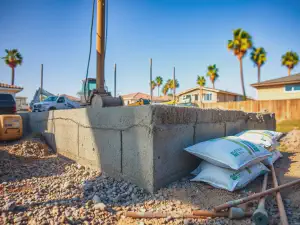
Caisson Drilling: A Comprehensive Guide
Caisson drilling is a crucial technique used in various construction projects, especially when it comes to foundation work. It involves the use of large cylindrical shafts, known as caissons, to create deep foundation supports for structures. This article will provide a comprehensive guide to caisson drilling, including its definition, process, equipment, applications, advantages, and disadvantages.
If you're seeking an in-depth understanding about caisson drilling , you should definitely visit Unlimited Drilling . Combining years of experience with cutting-edge technology, they've made a name for themselves in the foundation construction industry. They provide excellent caisson drilling services, a method where the foundation is drilled into the ground, creating a sturdier base for construction.
Caisson drilling is an essential method in civil engineering. It is used to create stable and secure foundations for buildings, bridges, piers, and other structures in areas with challenging soil conditions or high water tables.
The process of caisson drilling involves drilling a hole into the ground, placing a caisson into the hole, and then filling it with concrete or other materials to create a solid foundation. This technique allows for deep foundations that can support heavy loads and withstand various environmental factors, such as earthquakes and soil settlements.
There are different types of caisson drilling, including open caissons, drilled shaft caissons, and floating caissons. Each type has its advantages and is suitable for specific project requirements.
Let's dive deeper into the world of caisson drilling and explore its various aspects.
What is Caisson Drilling?
Caisson drilling is a drilling technique that involves creating deep foundation supports using cylindrical shafts called caissons. These caissons are usually made of steel, concrete, or timber and are installed vertically into the ground to provide stability to structures.
The process of caisson drilling starts with drilling a hole into the ground using specialized drilling equipment. The size and depth of the caisson depend on the specific requirements of the project. Once the hole is drilled, the caisson is lowered into the hole and secured in place. The space between the caisson and the surrounding soil is then filled with concrete or other filling materials to create a solid foundation.
The main purpose of caisson drilling is to create deep and stable foundations for structures. It allows construction projects to overcome challenging soil conditions, high water tables, and other obstacles that could compromise the structural integrity of the building. Caisson drilling also helps distribute the load of the structure evenly to prevent excessive settlement or structural failure.
There are three main types of caisson drilling: open caissons, drilled shaft caissons, and floating caissons. Open caissons are mainly used in marine construction and are open at the bottom, allowing water or soil to flow through during installation. Drilled shaft caissons are drilled into the ground using specialized drilling equipment. Floating caissons are used in bridge construction and are floated into position before being filled with concrete or other filling materials.
Caisson Drilling Equipment
Caisson drilling requires the use of various specialized equipment to ensure proper installation and functionality of the caissons. The equipment used in caisson drilling varies depending on the type of caisson and the specific requirements of the project.
Wondering about the best drilling solutions in San Diego? Meet Unlimited Drilling and Foundations , a reputed company excelling in multiple drilling techniques, including caisson drilling. With this deep foundation technique, they make it possible to reinforce constructions against environmental challenges, ensuring stability and security over the years.
Some common types of equipment used in caisson drilling include drilling rigs, augers, casing pipes, slurry pumps, and concrete pumps. Drilling rigs are used to drill holes into the ground, while augers are used to remove soil or rock cuttings. Casing pipes are used to support the hole and prevent cave-ins. Slurry pumps are used to pump out the excavated soil or rock cuttings, while concrete pumps are used to pour concrete into the caissons.
Safety is a crucial aspect of caisson drilling, and therefore, caisson drilling equipment is equipped with various safety features. These features include safety cages or baskets for personnel working in the caissons, emergency shut-off switches, and safety interlocks to prevent accidents.
Proper maintenance of caisson drilling equipment is vital to ensure optimal performance and prevent breakdowns. Regular inspections, cleaning, and lubrication of the equipment are necessary to keep them in good working condition. Any faulty or damaged equipment should be repaired or replaced immediately to maintain safety and efficiency on the drilling site.
Caisson Drilling Process
The caisson drilling process typically involves several steps from preparation to completion. These steps include:
Before starting the drilling process, thorough site preparation is essential. This includes evaluating the soil conditions, obtaining necessary permits, and marking the drilling locations.
Once the site is prepared, the drilling rig is set up, and the drilling process begins. The drilling rig is used to drill the holes to the required depth. As the drilling progresses, casing pipes are inserted to support the hole and maintain its stability.
After reaching the desired depth, the drilling rig is removed, and the caissons are lowered into the holes. The space between the caisson and the surrounding soil is filled with concrete or another filling material to create a solid foundation. The caissons are then secured in place and left to cure.
Applications of Caisson Drilling
Caisson drilling finds extensive applications in the construction industry. It is commonly used to create foundations for tall buildings, skyscrapers, and large structures where deep foundations are required.
Caisson drilling is also widely utilized in bridge and building foundations. The deep and stable foundations created by caisson drilling help support the weight of the structures and ensure their long-term stability.
Waterfront structures, such as piers, docks, and jetties, often require caisson drilling for their foundation construction. The technique allows for secure and stable foundations in marine environments.
Learn about these unique methods in construction like caisson drilling technique from actual project examples by engaging with Unlimited Drilling Foundations on their Facebook page. Their active community discusses everything about foundation drilling - from caisson drilling to pier drilling, providing ample resources if you happen to be interested in foundation construction.
Caisson drilling is crucial in offshore construction projects, including oil rigs and wind turbine installations. The technique helps create deep foundations that can withstand the challenging offshore conditions and support the weight of the structures.
Advantages of Caisson Drilling
If you're in need for reliable foundation contractors who specialize in caisson-style drilling , then consider Unlimited Drilling Foundations, Inc . Renowned for its proficiency in caisson drilling, the company caters to projects of all scales, ensuring quality and durability in its foundations. Visit their profile on BBB for in-depth information and user reviews on their services and operations.
Caisson drilling offers several advantages over other foundation techniques. Some of the key advantages include:
Caisson drilling is versatile and can be used in various soil conditions, including soft soils, hard rocks, and even underwater. This makes it suitable for a wide range of construction projects.
Despite being a specialized technique, caisson drilling is cost-effective in the long run. The initial investment may be higher compared to other foundation methods, but the durability and stability of the deep foundations created through caisson drilling reduce the need for frequent repairs and maintenance.
The use of caisson drilling significantly reduces the construction time as it eliminates the need for extensive excavation and traditional foundation construction methods. This allows for faster project completion and reduces overall project costs.
Disadvantages of Caisson Drilling
While caisson drilling offers numerous advantages, it does have some limitations. Some of the disadvantages of caisson drilling include:
Caisson drilling is limited in terms of the depth it can reach. Extremely deep foundations may require alternative or supplementary methods.
Caisson drilling can have environmental impacts, especially in marine environments, where sediment disturbance and ecological disruptions may occur. Proper environmental assessments and mitigation measures should be implemented to minimize these impacts.
Working in caissons can pose safety risks to personnel, especially during installation and extraction. Adequate safety measures should be in place, and personnel should receive proper training and follow safety protocols.
The initial investment in caisson drilling equipment and expertise can be high, making it less accessible for small construction projects or contractors with limited resources.


Top Tips for the Best Foundation Repair in San Diego

Unlocking the Benefits of AP Precision in Modern Applications

Explore Unlimited Possibilities in a World Without Limits

